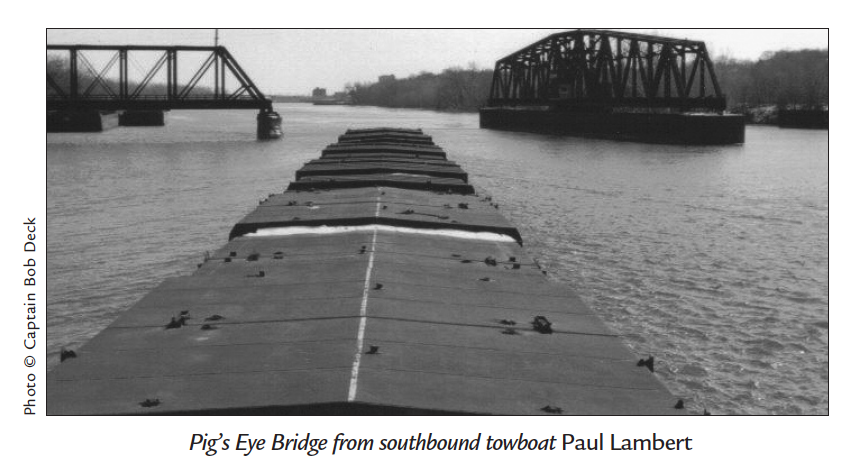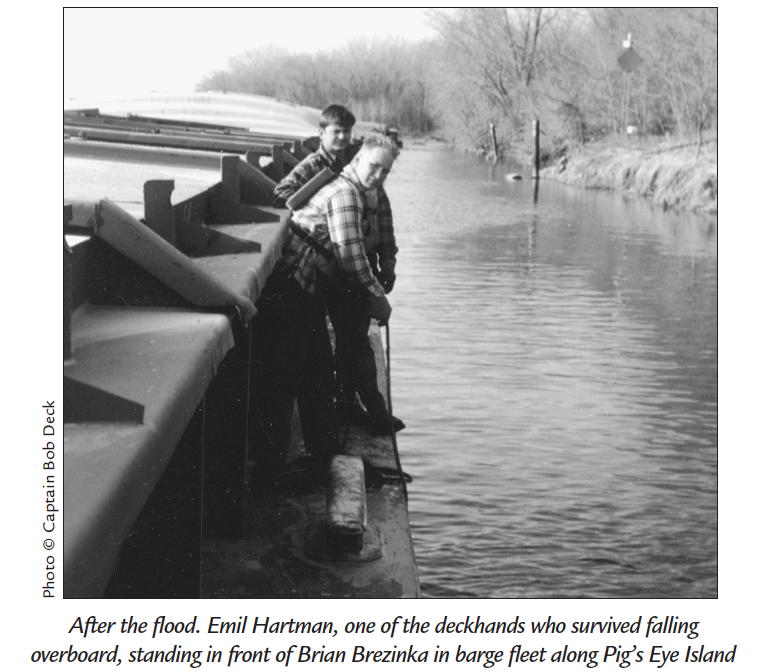From the 2011 St. Paul Almanac
A grizzled old towboat mate of twenty-six named Steamboat Bill explained
the dangers of working in high water to me in very simple,
very direct terms. “Rule number-one is: Don’t fall in! If you fall in, you’re
dead. It’s that simple. The current will drag you under and you’ll drown!”
He told me this from the deck of a barge moored in South Saint Paul in
the spring of 1975, when the Mississippi River was rising fast.
Years later I watched as another young deckhand learned this lesson.
It was spring of 1992 when he slipped on an icy deck and went into the
swirling frigid water under the Lafayette Street Bridge. Two of us were
right behind him, and we dropped to our knees and looked into the dark
water but could see nothing. A second later, a gloved hand shot up, and
we grabbed him before the current could carry him away. In seconds, we
dragged him into the galley and deposited the sputtering kid on the deck
next to an electric heater. He sat there blinking a few seconds before he
could stutter, “Th-the da-damn cu-cu-current t-t-took my nu-nu-nu-new
Sorrels right off my f-f-feet.”
The flood of 1993 was a time of learning for river man and animal
alike. In the early morning hours of June 23, the river rose high enough to
shut down railroad bridge operations, cover Shepard Road, and swallow
up Harriet and Pig’s Eye islands. Then, half the barges fleeted in South
Saint Paul broke loose. It took several boats to chase and round them up
before they could collide with the other fleets and 494 bridge and cause
some real catastrophe.
I later spoke with a deckhand who saw the breakaway. His boat was
holding four loads that had hit the far bank when they broke loose. He
pointed at a bare tree stump on the bank. It was about eight feet across
and looked to have been torn apart. “That big cottonwood tree just exploded
when the barges hit it!” he said.
One boat was released from cleanup to return to the wharf barge in
Pig’s Eye Lake and retrieve those of us who would work the day shift. Four
crews crowded onto the Lois E as she headed back out to the river to finish
securing a couple dozen barges. The high water had created some new
hazards as the current had increased. There is a shifting sandbar across
the river from the old packing houses where the current is dammed, causing
a series of rapids or standing waves with crests as high as five feet.

I watched from the port window of Lois E’s pilothouse as the pilot
guided the boat through the first of the waves. The square bow dipped
down and sank underwater before wallowing free of the river. As the boat
pushed toward the next wave, we spotted two adult deer swimming frantically
with the current. We watched helplessly as the pair of deer tried
vainly to swim through the waves to get to us. They must have been desperate
to think our noisy towboat would save them. When they were just
a few feet away, they turned together and swam downstream away from
the boat. Fatigue must have won out, because they disappeared between
the waves and we never saw them again.
We walked the barges, surveying the broken rigging, and someone
heard a mewing sound from the island, which had become completely
submerged. The current swirled around the trees many feet over what
had been solid ground days earlier.
In between the trees, a fawn struggled to stay above water. In response
to our coaxing, it swam to the edge of the barge, but then panicked and
swam around the upper end and out into the main channel. Worried
that it would meet the same fate as its parents, we turned the boat loose,
and the pilot guided us down close to the startled fawn. I held one of the
deckhands by his belt and lowered him down as he scooped the fawn out
of the river.
While the orphaned critter wandered about the galley, we made another
round of the fleet and managed to free a family of ducks caught between
two of the barges. It took a little effort with a broomstick to nudge them up
and out of the space to where their wings could spread enough to get away
from us. Sometime during the early afternoon, a U of M agriculture team
came to pick up the fawn at our wharf barge in Pig’s Eye Lake.
Later that day, my brother Doyle, who was the mate on another boat,
was training in a green deckhand. His boat was faced up on the upstream
end of a group of loaded barges. It was time to remove the long, heavy
wires that hold the boat to the barges. Doyle was strong and knew the
technique and quickly threw one of the wires onto the hook on the bow
of the boat.
“Don’t do that by yourself!” he yelled as the new kid set about to lifting
the other side wire from the timberhead on the barge. It was a warning
that was ignored or came too late. As soon as the wire was in his hands, he
leaned back and fell onto his rear as the wire pulled him over the end of the
barge and into the wicked current. By the time Doyle got to him, he had
lost his grip on the edge of the barge and was about to slip under the fleet
to drown for sure. Doyle dove along the deck, somehow managing to hang
over the end of the barge and reach down just in time to snag the kid’s
wrist before the current could suck him under the barges. He managed to
pull the greenie out of the river and dragged him onto the barge. As they
both slumped there catching their breath, Doyle said to him, “What did I
tell you? Don’t fall in the damn river! If you do, you’re dead.”

